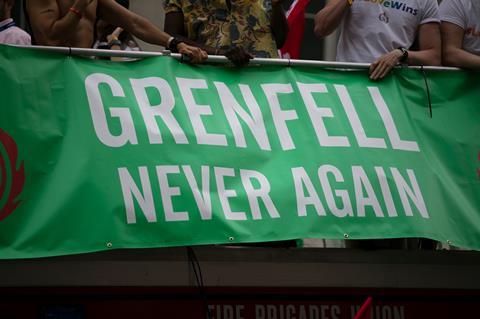Ministers have published their long-awaited plan in response to the inquiry into the Grenfell fire, which claimed 72 lives in 2017. Here is a guide to the key proposals.

The government said that it has taken action on all 58 recommendations made by the Grenfell Inquiry back in September.
Here are the key proposals for construction at-a-glance
A single construction regulator
The government has said it “accepts the intent of intent of the Inquiry’s recommendation to draw together functions relating to the construction industry under a single regulator”.
The single regulator will not however undertake testing and certification of construction products or issue certificates of compliance as the government believes this would create a conflict of interest.
Instead, it will “strengthen oversight of Conformity Assessment Bodies through reforms to the construction products regime”.
The government has already announced that all fire-related functions will move from the Home Office to the Ministry of Housing, Communities and Local Government (MHCLG), where they will be co-located with building safety and emergency response functions under one secretary of State
Chief construction adviser
Ministers have accepted the Inquiry’s recommendation to appoint a chief construction adviser to government. This person will advise the secretary of state, “monitor the department’s work relating to the building regulations, statutory guidance and the construction industry more generally”.
They will also “bring industry together and hold it to account to help design and deliver the progress we must make together to realise effective reform and culture change”.
The adviser is also expected to convene industry engagement into the design and implementation of the single regulator.
Products regulation reform
MHCLG this morning pledged tougher regulation “of those responsible for testing and certifying, manufacturing and using construction products with serious consequences for those who break the rules. “
It has published a lengthy green paper outlining reforms to strengthen the regulations for construction products.
These proposals include implementing a general safety requirement that applies to all currently unregulated construction products. This mandates that all manufacturers are responsible for assessing the safety risks associated with their products before they are marketed.
The national regulator would be given powers to impose sanctions against manufacturers and the regulator empowered to conduct inspections and surveillance to detect unsafe products.
The paper proposes requiring that all construction products feature clear, accessible labelling and product information that outlines critical safety information.
Product information must be understandable to a wide range of users, from construction professionals to everyday consumers. The intention is to promote transparency and empower clients and builders to make safety-critical decisions based on reliable information.
A central library of construction products would also be established, while digital product passports would be introduced with information on the safety, composition and potential hazards of each product.
Suppliers could be debarred from public work
Seven organisations criticised in the inquiry’s report, including Kingspan, Arconic and former Celotex owner Saint Gobain, will be investigated using new powers included in the Procurement Act, which came into force this week.
If certain grounds are met, these organisations will be added to a published “debarment list” which must be taken into account by contracting authorities when awarding new contracts.
Competence and training
The government in its response is proposing several measures to “create a thriving professional and skilled workforce”
It plans to legislate to make it mandatory for fire risk assessors to have their competence verified by an accreditation body and it will consider “how a licensing scheme for principal contractors on higher-risk buildings can best work along with requirements for principal designers.
It will direct the Regulator of Social Housing to set standards for the competence and conduct of staff, establish a panel to look at conflicts in building control and engage a panel of experts to consider how to ensure fire engineers “play their part in driving safety in design and delivery”. Ministers will also consult on a new College of Fire and Rescue later this year to improve training and professionalism of firefighters.
‘Empowering’ social housing residents
The Ministry for Housing, Communities and Local Government, said it wants to “empower social housing residents to challenge landlords and demand safe, high-quality housing”.
It said it would do this by expanding the Four Million Homes training programme, a government-funded training scheme designed to help improve resident engagement.
MHCLG is also pledging to make it easier for tenants to report safety concerns through its Make Things Right Campaign to raise awareness about tenants’ rights. It will also extend the Social Housing Quality Resident Panel, which sees residents share their expeirences with government.
Review of social housing management organisations
The government has also pledged to improve the governance and accountability of management organisations that manage social housing stock on behalf of councils, including Tenant Management Organisations (TMOs) and Arms Length Management Organisations (ALMOs). It will review the governance arrangements of these organisations.
The government noted that Grenfell tower manager Kensington & Chelsea Tenant Management Organisation (TMO) was unusually both a TMO and an ALMO
It said: “Residents were ignored and marginalised. Lines of accountability between RBKC and KCTMO were not as clear as they should have been.”
A call for evidence was launched earlier this year on the governance and accountability of management organisations including TMOs and ALMOs.
Residential personal emergency evacuation plans
The government has said it will lay new secondary legislation later this year mandating building-level evacuation plans for all high-rise residential buildings (and for medium-rise residential buildings with a simultaneous evacuation plan in place.).
It said: ”these measures will mandate that the building owner or manager engages with their vulnerable and disabled residents, considers how to improve their fire safety and evacuation, enables all residents to be clear on what they should do in the event of a fire, and give fire and rescue services information in case they need to support their evacuation.”
Review of the definition of higher-risk building
The government has said it accepts the inquiry’s recommendation that the definition of a higher-risk building - currently defined as above 18 metres- should be reviewed.
MHCLG and the Building Safety Regulator have carried out an initial review ”which considers the infancy of the regime and the limited existing evidence base on which to identify and assess further risks”.
It is therefore planning to set out details of an “ongoing” review in the summer. The government said this will ”help strengthen the building system, reassure residents and identify whether the list of buildings currently subject to the enhanced regulatory oversight and requirements of the higher-risk regime should be amended”.
‘Hillsborough law’
The government intends to introduce a new law compelling public authorities to “disclose the truth” in order to ensure transparency in major incidents while holding those responsible for failures to account.
More on the government’s response to the Grenfell Inquiry
Social housing tenants to be ‘empowered’ to challenge landlords
Seven firms could be disbarred from taxpayer contracts over Grenfell failings










No comments yet